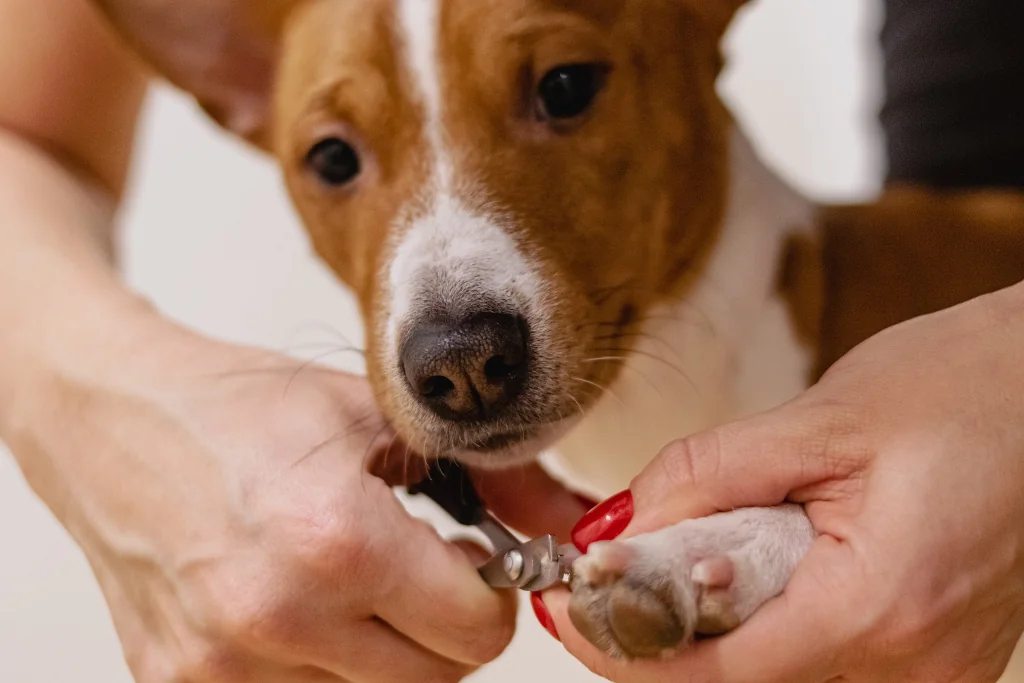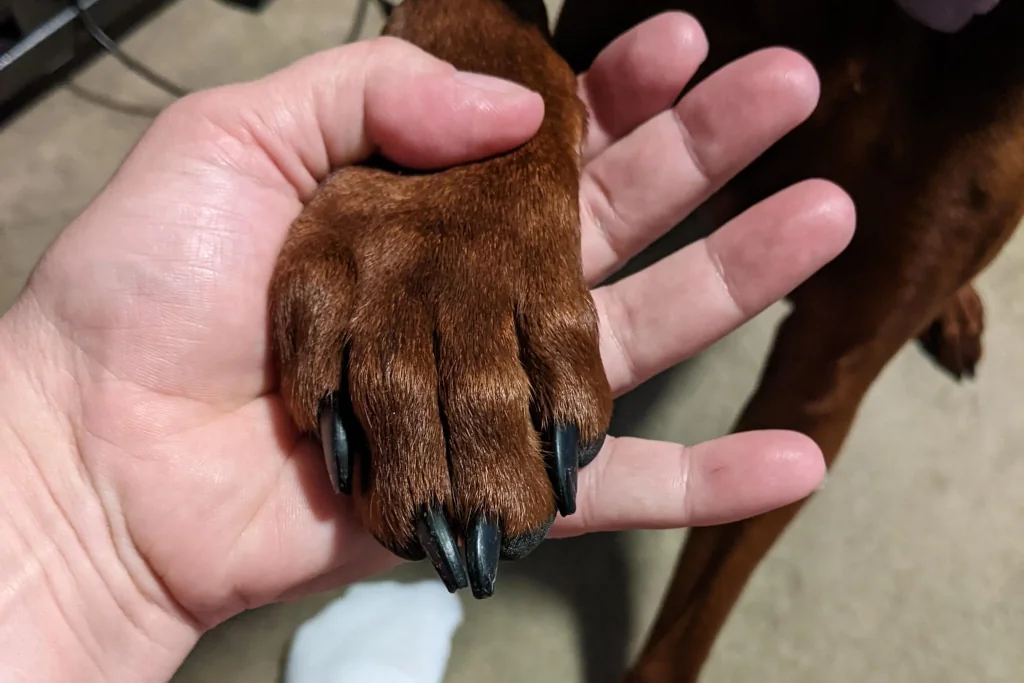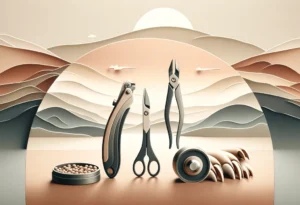Disclosure: We may earn a commission from helpful, relevant links in our content. No cost to you. See our privacy policy.
Ouch! A scratched leg from an excited dog’s overly long nails is far from pleasant, right?
More importantly, for your furry friend, those long nails can lead to discomfort and health issues.
Trimming your dog’s nails is a must-do, not an option. It’s about their health, their comfort, and yes, your unscratched skin. But, how to start without turning it into a wrestling match?
Well, with years of experience and a myriad of tried and tested techniques, we’re here to guide you. Grab those clippers or grinder, take a calming breath, and let’s do this together for your dog’s happy, healthy paws.
And don’t worry, we’ve got your back every snip and grind of the way.

Why Should You Trim Your Dog’s Nails Regularly?
Trimming your dog’s nails isn’t just about aesthetics or the comfort of not being scratched. It’s an essential part of your dog’s health and wellbeing.
Untrimmed nails can cause discomfort to your dog when walking, alter their posture, and eventually lead to a variety of joint and skeletal issues. Long nails can also break or split painfully, making your dog susceptible to infections.
Regular nail trimming helps ensure your dog maintains a healthy gait, keeps their paws pain-free, and minimizes any risk of injuries. So, let’s keep those paws healthy, one clip at a time!
The Anatomy of Your Dog’s Nails: Where to Cut?
Let’s get a bit scientific here – a dog’s nail consists of the outer hard shell and the inner softer cuticle, often called the ‘quick’.
The quick is where it gets tricky. This part is sensitive and has blood vessels. You should aim to cut the hard part without hitting the quick to avoid causing discomfort or pain to your pooch.
If your dog has lighter nails, spotting the quick should be easier – it’s the pinkish area. For those with darker nails, things can get a bit more challenging, but don’t worry, we’ve got you covered in the following sections.
Remember, the goal here is to trim without causing any pain or fear, turning the nail-trimming ordeal into a walk in the park – for both of you. So, let’s get snipping the right way!
Clippers vs Grinders: Which is Best for Your Dog?
Choosing the right tool for your dog’s nail trimming could mean the difference between a relaxed grooming session and an all-out, hide-and-seek game around the house.
Broadly speaking, you have two options: clippers or grinders.
Clippers are the traditional tools, and they come in two types – guillotine-style and scissors-style. The guillotine-style is useful for small to medium dogs with softer nails, whereas the scissors-style, like the Safari Professional Nail Trimmer, is great for larger dogs with tougher nails.
Clippers give a quick, clean cut but require some precision and confidence to use effectively.
On the other hand, grinders are becoming increasingly popular. They grind down the nail gradually, offering more control over how much nail you remove. This tool is especially suitable for dogs with thicker nails and for those pet parents nervous about over-clipping.
The Dremel PawControl Dog Nail Grinder Kit is an excellent option, with multiple speed settings and easy handling. Grinders are less likely to cause accidental injury. Since they create a bit of noise and vibration, they might require some getting used to for your pooch.
In deciding between clippers and grinders, consider your dog’s size, nail thickness, and tolerance to noise, as well as your comfort level in using the tools.
Both can work wonders when used correctly and patiently.
Suggested reading: Dog brushing and combing guide
How to Handle Dark or Black Dog Nails?

Unlike clear nails where the quick is visible, dark nails give no such clue. However, there are methods to trim these nails safely and effectively.
One technique is to make several small trims. Start from the tip of the nail and gradually move towards the base. After each cut, look at the cross-section of the nail. At first, you will only see a homogeneous dark area. As you get closer to the quick, you will begin to see a grey or white circle starting to appear in the middle of the nail – that’s your cue to stop.
If you’re using a grinder, the same principle applies. Begin from the end, grind slowly and observe the nail head after each pass.
In both cases, if your dog pulls away or appears uncomfortable, it might be time to stop. You don’t have to get it perfectly short in one session. Remember, it’s all about making the experience safe and stress-free for both of you.
Another helpful tool for dark nails is a nail clipper with a built-in LED light, like the Pawsibility Nail Clipper with Ultra Bright LED Light. It illuminates the nail, making it easier to spot the quick and prevent over-trimming.
Lastly, always have a styptic powder like “Kwik Stop” on hand. It helps stop bleeding quickly if you accidentally cut into the quick. With practice and patience, dark nails won’t be a challenge anymore. You’ve got this!
Suggested reading: Dog Care – Your Dog’s Ear Cleaning Guide
Dealing with an Uncooperative Dog During Nail Trimming
If your dog views nail trimming as a worrisome event, it can become quite a feat to even get them in the same room as the nail clippers.
But don’t worry, we’ve got strategies to make this a fuss-free routine for you both.
First off, conditioning is key. Begin by getting your dog comfortable with their paws being handled. You can incorporate this during your daily cuddles, gently massaging their paws and rewarding them for their calm behavior.
Next, introduce the nail trimmers or grinder without the intention of trimming. Let your dog sniff them, place them near their paws, and always pair these interactions with their favorite treats. This way, the tool becomes a source of positive associations.
Once you’re ready for the actual trimming, do not aim for perfection in one go. A single nail or even a small trim is progress. Celebrate these small victories and keep the energy positive.
Remember, your patience and calm demeanor are what your dog draws upon.
Pro Tip:
Here’s a unique tip most people overlook: Try changing the environment. I remember when my older dog, Sam, used to squirm and try to slip away during his nail-trimming sessions. So one day, I tried doing it outside, his favorite place, under his beloved apple tree. His usual anxiety eased significantly, and we’ve made it our nail-trimming spot ever since. So, the environment can play a significant role; you might want to explore this.
Natural Ways to Keep Your Dog’s Nails Short

Regular walks on different surfaces, particularly on concrete or asphalt, can naturally wear down your dog’s nails.
Playing fetch on a hard surface or incorporating some agility-like drills in a safe, enclosed concrete area can also help keep those nails in check.
A less-known, yet effective way, is to teach your dog to use a scratching board. Yes, just like cats! It may sound a bit unusual, but it’s a great natural way to keep their nails short. I taught my younger dog, Charlie, to use a makeshift board with a bit of sandpaper attached. It was fun, almost like a game for him, and I noticed a significant reduction in his nail growth over time.
Remember, while these methods can help maintain your dog’s nails, they do not replace regular nail trimming. Regular checkups are still necessary to ensure their nails are at a comfortable and healthy length.
Looking for other dog grooming guides? Check out dog brushing and bathing guide, as well as how to choose the right dog brush.
FAQs
How Often Should You Cut Your Dog’s Nails?
On average, most dogs need their nails trimmed once a month, although some active dogs may require less frequent trimming due to natural wear from physical activity.
Is it Better to Clip or Grind Dog Nails?
Clippers provide a quick, clean cut but require more precision, while grinders offer more control and are less likely to injure the quick, making them suitable for beginners or dogs with thicker nails. The choice comes down to the dog’s tolerance and your comfort level.
Does Walking Your Dog Trim Their Nails?
Yes, walking your dog, especially on hard surfaces like concrete or asphalt, can help naturally trim their nails. However, this should not replace regular nail trimming, as walking might not wear the nails evenly.
Can Overgrown Dog Nails Cause Health Issues?
Overgrown dog nails can cause various health issues. They can cause discomfort while walking, lead to posture problems, and increase the risk of painful nail splits or breaks. In severe cases, the nails can curve into the paw pad, leading to infections.
Alex, a passionate animal lover, has experience in training and understanding animal behavior. As a proud pet parent to two dogs and three cats, he founded AnimalReport.net to share insights from animal experts and expand his knowledge of the animal kingdom.




